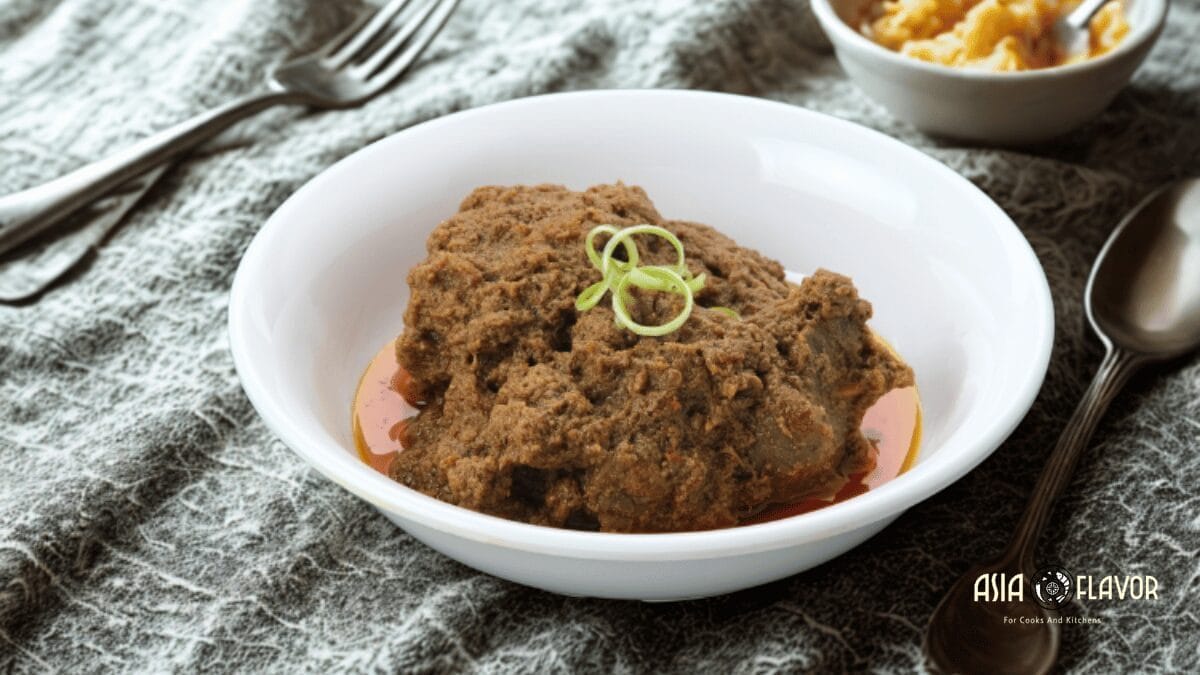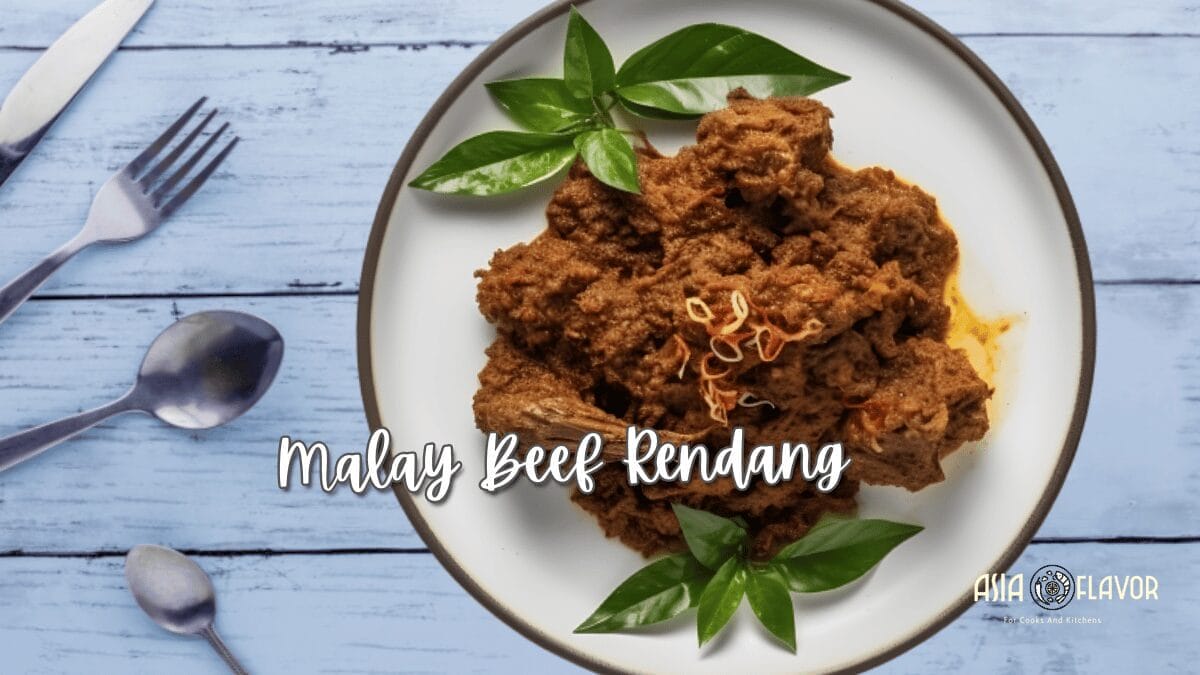Welcome to an exploration of Malay Beef Rendang – a dish deeply rooted in Malaysian culinary heritage that boasts a symphony of flavors and a legacy of tradition. In this blog post, you’ll get the very best Beef Rendang recipe, and we will explore the history, regional variations, and key ingredients that make this dish a masterpiece.
History: A Tapestry of Culinary Heritage
Originating from the Minangkabau ethnic group of Indonesia, Malay Beef Rendang has evolved over centuries to become a beloved dish not only in Malaysia but also across Southeast Asia. With influences from the spice trade and diverse cultural exchanges, Rendang has become a cornerstone of Malay cuisine, celebrated for its rich flavors and aromatic spices.
Initially a dish reserved for special occasions and festivities, Rendang has transcended its humble origins to attain global recognition, enchanting palates with its complex blend of flavors and tender meat simmered to perfection. Its journey from a traditional dish to a culinary icon showcases the adaptability and enduring appeal of Malay cuisine.

Regional Variations: Diverse Interpretations of a Classic Dish
As with many traditional dishes, Malay Beef Rendang exhibits regional variations that reflect local preferences and ingredient availability. In Malaysia alone, each state adds a unique twist to the recipe, resulting in a diverse tapestry of flavors and cooking techniques. Here are some notable regional variations:
- Negeri Sembilan: Known for its spicy Rendang, the version from Negeri Sembilan features a generous amount of chilies and a bold, fiery flavor profile.
- Perak: Perak’s rendition of Rendang is characterized by a thicker gravy, achieved by reducing the coconut milk to a rich, creamy consistency.
- Kelantan: In Kelantan, Rendang is often prepared with a hint of sweetness, balancing the heat with palm sugar or sweet soy sauce.
Exploring these regional nuances not only adds depth to the culinary journey but also underscores the versatility of Malay Beef Rendang as a dish that can be customized to suit various preferences and palates.

Key Ingredients: Crafting the Essence of Rendang
At the heart of Malay Beef Rendang recipe lies a carefully curated selection of spices and aromatics that lend depth and complexity to the dish. While the precise blend of ingredients may vary from one recipe to another, certain key elements remain constant, defining the unmistakable essence of Rendang. Here are some essential ingredients:
- Beef: Traditionally prepared with beef, this dish benefits from cuts like brisket or chuck that tenderize beautifully during the slow cooking process, absorbing the flavors of the sauce.
- Coconut Milk: A cornerstone of Malay cuisine, coconut milk imparts a creamy texture and a subtle sweetness to the Rendang, balancing the heat of the spices.
- Galangal and Lemongrass: These aromatic ingredients infuse the dish with a citrusy, earthy flavor that forms the backbone of Rendang’s distinctive taste profile.
- Spice Blend: A harmonious blend of spices such as turmeric, cinnamon, cloves, and cardamom creates a pungent depth of flavor that elevates the dish to culinary greatness.
- Kerisik (Toasted Coconut Paste): Essential for achieving a rich, nutty flavor, kerisik adds a depth of complexity to the Rendang sauce, enhancing its overall richness.
By carefully selecting and combining these key ingredients, you can unlock the true essence of Malay Beef Rendang, creating a dish that embodies the soul of Malaysian cuisine.
Malay Beef Rendang Recipe
Now let’s move on to the recipe, showcasing the art of preparing Malay Beef Rendang recipe. Happy cooking and bon appétit!
Malay Beef Rendang Recipe (Authentic Resepi Rendang Daging)
6
people25
minutes3
hours550
3
hours25
minutesBeef Rendang (rendang daging), the way you’ll find it in homes and the best hawker stalls. A curry with meltingly tender beef, slow cooked in a rich, aromatic and highly spiced coconut gravy.
Keep the screen of your device on
Ingredients
- For The Beef
1 kg 1 braising or stewing beef
500 ml 500 coconut cream
250 ml 250 water
2 2 lemongrass stalk
2 2 turmeric leaves (large)
1 tsp 1 salt
1 1 cinnamon stick
3 3 star anise
5 5 cloves
5 5 cardamom
6 6 Kaffir Lime Leaves
1 tsp 1 Tamarind
1 tbsp 1 coconut palm sugar
2 tsp 2 salt
120 grams 120 kerisik
60 ml 60 oil
250 ml 250 water; if needed
- For The Spice Paste
1 1 lemongrass stalk
1 inch 1 galangal
1 inch 1 ginger
5 5 garlic coves
20 20 dried red chili
2 large 2 onions
2 tbsp 2 kerisik
1 inch 1 fresh turmeric; (see notes)
1 tbsp 1 coriander seeds
1 tsp 1 cumin
Directions
- Prepare The Spice Paste
- Chop the dried red chili in pieces and place in a bowl of hot water to soak around 20 minutes. Drain the chilies and add them to a blender. Chop up the remaining spice paste ingredients and add to the blender. Don’t be tempted to add water! You will not need it! Blend until you have a fairly smooth mix. It does not need to be entirely smooth (but smooth is better than chunky)

- Pour 60ml oil into a heavy pot or wok. When it’s hot, add the cinnamon stick, star anise, cloves, and cardamom pods. Cook over low to medium heat for around 1 minute. Stir in the blended spice paste and sauté for 3-5 minutes until it starts to become fragrant and the paste has slightly darkened in color.

- Bruise the lemongrass with a rolling pin (or something heavy) and add it along with the beef and torn lime leaves to the pan. Stir well and allow the beef to express it’s water. You’ll see the beef juices being released. Stir continuously until the liquid has evaporated, the beef will have shrunk slightly and the spice paste should be drier still.. This process should take around 10 minutes.

- Add coconut milk, salt, palm sugar, tamarind paste, and kerisik. Stir everything together and increase the heat until it reaches a boil. Once boiling, reduce the heat to the lowest setting possible. Cover with a lid and let it simmer for 2 hours.

- Every 20 to 30 minutes, check the pot and stir to ensure everything combines. This helps to spread the caramelizing coconut milk evenly. Ensure you scrape off any bits that stick to the bottom to avoid burning. I use a wooden spatula. If you notice the rendang is drying too quickly or the juices have gone before the beef is tender, you can add some or all of the optional water throughout the cooking. During the last half hour, watch the rendang more closely and stir more frequently. Most of the liquid will have evaporated by then, making the spices more likely to burn. The rendang is ready when the beef is soft and tender and the spice paste has transformed into a sticky, dry coating! Enjoy!

Equipment
Notes
- I know that depending where you live in the world finding fresh turmeric may be difficult. If you cant use fresh you can add 1 tsp of dried turmeric powder. It will be equally delicious.
- Brown sugar can be used in place of coconut palm sugar (as can white sugar)
- If you are using Tamarind pulp, let it soak in 3-4 tbsp water for 15 minutes, then add the water and pulp to the beef. It makes is easier to incorporate.
Nutrition Facts
- Serving Size: 1g
- Total number of serves: 4
- Calories: 550kcal
- Fat: 40g
- Saturated Fat: 30g
- Trans Fat: 0g
- Polyunsaturated Fat: 3g
- Monounsaturated Fat: 5g
- Cholesterol: 100mg
- Sodium: 500mg
- Potassium: 800mg
- Carbohydrates: 15g
- Fiber: 5g
- Sugar: 4g
- Protein: 40g
- Vitamin A: 200IU
- Vitamin C: 10mg
- Calcium: 50mg
- Iron: 8mg
- Vitamin D: 0mg
- Vitamin E: 2mg
- Vitamin K: 5mg
- Thiamin: 0.2mg
- Riboflavin: 0.2mg
- Niacin: 10mg
- Vitamin B6: 0.5mg
- Vitamin B12: 2mg
- Folate: 15mg
- Biotin: 0mg
- Pantothenic Acid: 0mg
- Phosphorus: 200mg
- Iodine: 0mg
- Magnesium: 30mg
- Zinc: 4mg
- Selenium: 25mg
- Copper: 0.3mg
- Manganese: 0.3mg
- Chromium: 0mg
- Molybdenum: 0mg
- Chloride: 0mg
Did you make this recipe? We’d love to see it!
Tag @healthynatured on Instagram and add the hashtag#asiaflavor
Like this recipe?
Follow @healthynatured on Pinterest
Join us on Facebook!
Follow Taste of Asia Flavor on Facebook
Conclusion: A Flavorful Tapestry of Tradition and Innovation
Malay Beef Rendang stands as a testament to Malaysian cuisine and culinary heritage, blending tradition with innovation to create a dish that captivates the senses and delights the palate. Whether enjoyed in its traditional form or savored with a modern twist, Rendang continues to inspire chefs and food enthusiasts worldwide, inviting them to partake in a culinary journey rich in history, flavor, and cultural significance.











